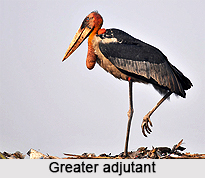 Greater adjutant is an Indian bird, bears with a scientific name "Leptoptilos dubius" is a member of the stork family, Ciconiidae.
Greater adjutant is an Indian bird, bears with a scientific name "Leptoptilos dubius" is a member of the stork family, Ciconiidae.
Concentration of Greater adjutant
Greater adjutant includes the lesser adjutant of Asia and the marabou stork of Africa. Once found widely across southern Asia, mainly in India but extending east to Borneo, the greater adjutant is now restricted to a much smaller range with only two small breeding populations; one in India with the largest colony in Assam and the other in Cambodia. Populations disperse after the breeding season.
Bill of Greater adjutant
Greater adjutant has a massive wedge-shaped bill, a bare head and a distinctive neck pouch. During the day, they soar in thermals along with vultures with which they share the habit of scavenging. They feed mainly on carrion and offal; however, they are opportunistic and will sometimes prey on vertebrates.
Structure of Greater adjutant
Greater adjutant is a huge bird, standing tall at 145-150 cm. The average length is 136 cm (54 in) and average wingspan is 250 cm. While no weights have been published for wild birds, the greater adjutant is among the largest of living storks, with published measurements overlapping with those of the jabiru, saddle-billed stork.
Juvenile greater adjutant storks in captivity weighed from 8 to 11 kg. For comparison, the heaviest known wild stork was a marabou stork scaling 8.9 kg. The huge bill, which averages 32.2 cm long, is wedge-like and is pale grey with a darker base. The wing chord averages 80.5 cm, the tail 31.8 cm and the tarsus 32.4 cm in length. With the exception of the tarsus length, the standard measurements of the greater adjutant are on average greater than that of other stork species. A white collar ruff at the base of its bare yellow to red-skinned neck gives it a vulture-like appearance. In the breeding season, the pouch and neck become bright orange and the upper thighs of the grey legs turn reddish. Adults have a dark wing that contrasts with light grey secondary coverts. The underside of the body is whitish and the sexes are indistinguishable in the field. Juveniles are a duller version of the adult. The pendant inflatable pouch connects to the air passages and is not connected to the digestive tract.
 Concentration of Greater adjutant
Concentration of Greater adjutant
Greater adjutant was once a widespread winter visitor in the riverine plains of northern India, however their breeding areas were largely unknown for a long time until a very large nesting colony was finally discovered in 1877 at Shwaygheen on the Sittaung River, Pegu, Myanmnar and it was believed that the Indian birds bred there.
Breeding Season of Greater adjutant
This breeding colony, also included spot-billed pelicans (Pelecanus philippensis), declined in size and entirely vanished by the 1930s. Subsequently, a nest site in Kaziranga was the only known breeding area until new sites were discovered in Assam, the Tonle Sap Lake and in the Kulen Promtep Wildlife Sanctuary. In 1989, the breeding population in Assam was estimated at about 115 birds and between 1994 and 1996 the population in the Brahmaputra River valley was considered to be about 600. A small colony with about 35 nests was discovered near Bhagalpur District in 2006.
Colonies of Greater adjutant
Greater adjutant breeds during winter in colonies that may include other large water birds such as the spot-billed pelican. The nest is a large platform of twigs placed at the end of a near-horizontal branch of a tall tree. Nests are rarely placed in forks and an unobstructed top canopy allows the birds to fly easily from and to the nests. In the Nagaon nesting colony in Assam, tall Alstonia scholaris and Anthocephalus cadamba were favourite nest trees.



















